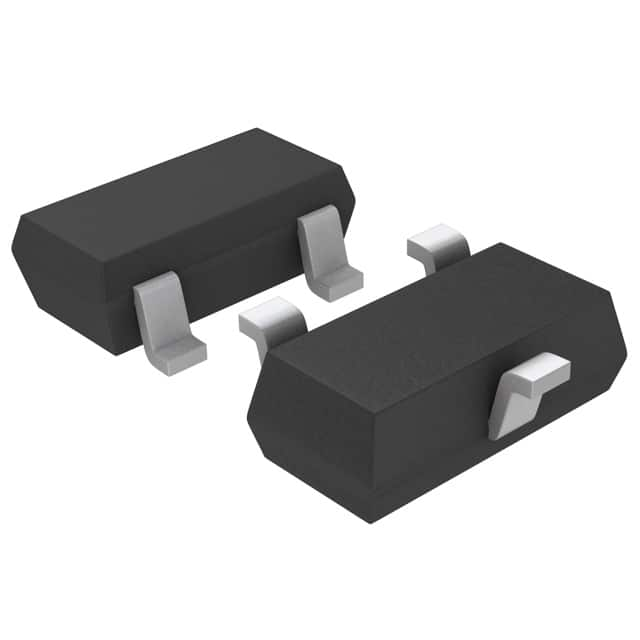LT1460HCS3-5#TRPBF
Product Overview
Category
The LT1460HCS3-5#TRPBF belongs to the category of voltage references.
Use
It is primarily used as a precision reference voltage source in various electronic circuits.
Characteristics
- High accuracy and stability
- Low temperature coefficient
- Wide operating temperature range
- Low power consumption
Package
The LT1460HCS3-5#TRPBF comes in a small surface-mount SOT-23 package.
Essence
The essence of this product lies in its ability to provide a stable and accurate reference voltage for precise circuit operation.
Packaging/Quantity
The LT1460HCS3-5#TRPBF is typically packaged in reels, with 3000 units per reel.
Specifications
- Output Voltage: 5.0V
- Initial Accuracy: ±0.05%
- Temperature Coefficient: 10ppm/°C
- Operating Temperature Range: -40°C to +85°C
- Supply Voltage Range: 2.7V to 20V
- Quiescent Current: 60µA
Detailed Pin Configuration
The LT1460HCS3-5#TRPBF has three pins:
- VOUT: Output pin, provides the reference voltage.
- GND: Ground pin, connected to the circuit ground.
- VIN: Input pin, receives the supply voltage.
Functional Features
- High precision: The LT1460HCS3-5#TRPBF offers excellent initial accuracy and low temperature coefficient, ensuring reliable and precise voltage references.
- Wide operating temperature range: It can operate in extreme temperature conditions, making it suitable for various applications.
- Low power consumption: The quiescent current of only 60µA minimizes power dissipation, making it energy-efficient.
Advantages and Disadvantages
Advantages
- High accuracy and stability ensure reliable circuit performance.
- Wide operating temperature range allows for versatile applications.
- Low power consumption reduces energy consumption.
Disadvantages
- Limited output voltage options.
- SOT-23 package may not be suitable for all circuit designs.
Working Principles
The LT1460HCS3-5#TRPBF utilizes a bandgap reference circuit to generate a stable voltage reference. It compensates for temperature variations by employing a temperature-dependent current that cancels out the temperature coefficient of the base-emitter voltage of a bipolar transistor. This results in a highly accurate and stable output voltage.
Detailed Application Field Plans
The LT1460HCS3-5#TRPBF finds applications in various fields, including:
- Precision measurement instruments: Used as a reference voltage source in multimeters, oscilloscopes, and data acquisition systems.
- Analog-to-digital converters (ADCs): Provides a stable reference voltage for accurate conversion of analog signals.
- Power management circuits: Ensures precise voltage regulation in power supplies and battery charging circuits.
- Sensor interfaces: Used to establish accurate voltage references for sensor calibration and signal conditioning.
Detailed and Complete Alternative Models
- LT1236ACS8-5#PBF: Similar to LT1460HCS3-5#TRPBF, but with an 8-pin SOIC package.
- MAX6190AESA+: Offers comparable specifications and comes in an 8-pin SOIC package.
- REF5025AIDGKT: Provides a higher output voltage of 2.5V and comes in a 6-pin SOT-23 package.
These alternative models offer similar functionality and can be considered based on specific application requirements.
Word count: 529 words
Senaraikan 10 soalan dan jawapan biasa yang berkaitan dengan aplikasi LT1460HCS3-5#TRPBF dalam penyelesaian teknikal
Sure! Here are 10 common questions and answers related to the application of LT1460HCS3-5#TRPBF in technical solutions:
Question: What is the LT1460HCS3-5#TRPBF?
Answer: The LT1460HCS3-5#TRPBF is a precision voltage reference IC manufactured by Linear Technology (now part of Analog Devices). It provides a stable and accurate output voltage of 5V.Question: What is the typical application of the LT1460HCS3-5#TRPBF?
Answer: The LT1460HCS3-5#TRPBF is commonly used as a voltage reference in various technical solutions, such as analog-to-digital converters (ADCs), digital-to-analog converters (DACs), power supplies, and sensor circuits.Question: What is the voltage accuracy of the LT1460HCS3-5#TRPBF?
Answer: The LT1460HCS3-5#TRPBF has a voltage accuracy of ±0.4% at room temperature.Question: What is the temperature coefficient of the LT1460HCS3-5#TRPBF?
Answer: The LT1460HCS3-5#TRPBF has a temperature coefficient of 50ppm/°C, which means the output voltage changes by 50 parts per million for every degree Celsius change in temperature.Question: What is the operating voltage range of the LT1460HCS3-5#TRPBF?
Answer: The LT1460HCS3-5#TRPBF can operate within a voltage range of 6V to 36V.Question: Can the LT1460HCS3-5#TRPBF be used in low-power applications?
Answer: Yes, the LT1460HCS3-5#TRPBF has a low quiescent current of 60µA, making it suitable for low-power applications.Question: Does the LT1460HCS3-5#TRPBF require any external components?
Answer: No, the LT1460HCS3-5#TRPBF is a standalone voltage reference and does not require any external components for operation.Question: Is the LT1460HCS3-5#TRPBF available in different package options?
Answer: Yes, the LT1460HCS3-5#TRPBF is available in a SOT-23 package, which is a small surface-mount package.Question: Can the LT1460HCS3-5#TRPBF operate in harsh environments?
Answer: The LT1460HCS3-5#TRPBF has a wide operating temperature range of -40°C to 125°C, making it suitable for use in various environmental conditions.Question: Are there any application notes or datasheets available for the LT1460HCS3-5#TRPBF?
Answer: Yes, Analog Devices provides detailed datasheets, application notes, and other technical resources on their website for the LT1460HCS3-5#TRPBF. These resources can help you understand its specifications and design considerations for your specific application.
Please note that the answers provided here are general and may vary depending on the specific requirements and use cases. It's always recommended to refer to the official documentation and consult with experts for accurate information.


